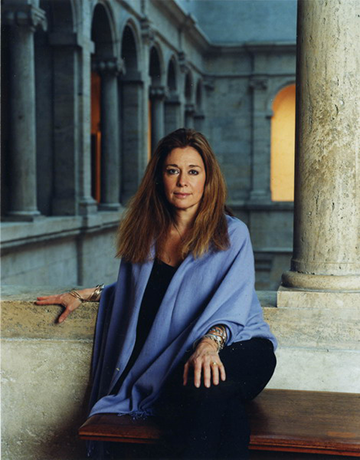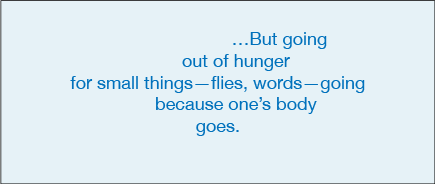Muriel Rukeyser says in The Life of Poetry that in order to successfully read a poem, we must give a poem “a total response.” This means giving it all our attention, taking it in slowly, reading it several times. It means listening to the poem openly, without judgment, and without projecting our own assumed meanings onto it, but rather as Ruykeyser writes, coming “to the emotional meanings at every moment.” As she explains, “That is one reason for the high concentration of music in poetry.”
To come to emotional meanings at every moment means to adjust and react to the way a poem takes shape with every word, every line, every sentence, every stanza. Each poem creates its own universe as it moves from line to line. It is a universe that Ruykeyser describes as the “universe of emotional truth.”
So how exactly do you listen with your emotions? Reading is one of the most intimate forms of connection you can have with someone. You take their words—their breath—into yourself. You shape the words with your own body and, too, give them life with your own breath. Reading poetry, you breathe in what a poet breathes out. You share breath. The words and their meanings become part of your body as they move through your mind, triggering sensations in your body that lead to thoughts. And through this process, you have experiences that are new and that change you as much as any other experience might.
Poetry is a condensed art form that produces an experience in a reader through words. And though words may appear visually as symbols on the page, the experience that poems produce in us is much more physical and direct. The elements of poetry permit a poet to control many aspects of language—tone, pace, rhythm, sound—as well as language’s effects: images, ideas, sensations. These elements give power to the poet to shape a reader’s physical, emotional, intellectual, and spiritual experience of the poem. Because form and function are so closely intertwined, it is impossible to paraphrase a poem. When author Michelle Bonczek Evory was an undergraduate, her first poetry teacher Anthony Piccione used to say, “A poem is what a poem does.” This is why we must read poems with full concentration and focus more than once. It is why we must read them out loud. It is why we must be attentive to every aspect of the poem on both ends: as a writer, and as a reader.
Readers come to the page with different backgrounds and a range of different experiences with poetry, but how we read a poem determines our experience of it. By “read” I do not mean understand or analyze, but rather, the actual process of coming to the poem, ingesting its lines, and responding emotionally.

Be a Good Listener
I would guess that all of us have heard someone described as a “a good listener” in our lifetimes. Well, what is it that makes someone a good listener? List the qualities you associate with good listening skills and think about your experiences of people who demonstrate these skills. In contrast, what makes someone a “bad listener”? How can you relate these concepts to reading a poem?
Being a good listener requires many of the same traits as being a good reader. When you listen to someone speak, you listen to their emotions and ideas through meaning and tone, body gestures, and emphasized words. You do not judge or interrupt. Before offering advice, condolences, or other reactions, you as a listener try to see their perspective and its complexities from their side. Good listeners take their identities out of the equation and place the speaker’s concerns in the middle of their attention. Every poem has a speaker that seeks connection with a listener.
A poet seeks to create an emotional experience in the reader through the poem’s process, just as if a friend—or stranger—were telling an intense story. Unlike a person speaking, who can use the entire body to gesture, poetry has only a voice to rely on to speak. Yet the poem seeks to speak to a reader as if it had a body. The poem uses rhythm, pauses, stresses, inflections, and different speeds to engage the listener’s body. As a reader, it is your role to listen to the speaker of the poem and to embody the words the speaker speaks with your own self as if you are the one who has spoken. Readers identify with the speaker, with the voice of the poem. Good readers listen with what John Keats called a “negative capability,” meaning you are capable of erasing your own identity and ego in order to imagine what it is like to take on another. Although Keats used the term to apply to the writing side of poetry, it is useful to consider the concept in terms of the reading side of the equation, as well.
Like individuals, each poem’s speaker speaks from a perspective, physical and/or psychological. As the reader moves word to word, line to line, you must allow the universe of the poem to take root in your imagination as if it is the only universe that exists. When you are open to the words’ music and meaning, the poem has the potential to envelop your entire being and body, as poet Emily Dickinson expresses in one of her letters:
If I read a book [and] it makes my whole body so cold no fire can ever warm me I know that is poetry. If I feel physically as if the top of my head were taken off, I know that is poetry. These are the only way I know. Is there any other way.
Dickinson speaks of the poem affecting her entire body and being. Great poetry does this, Rukeyser explains, because of the musical language, one of the most important properties of poetry. Music is seductive. Music is instinctual beyond language. Music is a universal language. When accompanied by language, it has the power to affect our senses and our sensibility in intense ways.
How to Conduct a Close Reading of a Poem
School photo created by mindandi – www.freepik.com
The Title Matters
Start at the beginning—the title, which sets up an expectation for the poem. A title can set a mood or tone, or ground us in a setting, persona, or time. It is the doorway into the poem. It prepares us for what follows.
The First Time Through
Read the poem out loud. Listen for the general, larger qualities of the poem like tone, mood, and style. After reading through once aloud, read it again silently, and this time look up any words you cannot define. Circle any phrases that you don’t understand and mark any that stand out to you. Some questions we may ask ourselves include:
We can apply this approach to the following poem by Jorie Graham:

Begin with the title: “I Watched a Snake.” What does this title do to you? What kind of expectations and tone does it set up?
Perhaps you expect a poem about observing nature, like a David Attenborough documentary, or maybe the blunt, declarative statement leads you to anticipate a list of other things the speaker has seen, or maybe you expect a poem about the speaker’s feelings about snakes.
Images and Tone
After an initial introduction to the poem, read slowly and allow the meanings to emerge as you move from line to line, paying attention next to images and tone. Before moving ahead, ask what your emotional response is at the end of each line, as lines can create different meanings and give the poem complexity. For instance, in the following stanza excerpt, we respond one way to the first two lines’ image, and another way after its turn to the fourth line:

The phrase “just as we/stitch the earth,” forms an image with what precedes before it can form an image with what follows. The line leaves us with the image of “we” (in this case, all people, the speaker and the reader and everybody else) doing something to the earth, stitching it, which sounds like sewing, but might be planting (sowing!). It is preceded by the image of the snake moving through grass, and so I am left expecting another image of living, of movement, but that expectation is reversed with the next lines: “it seems to me, each time/we die, going/ back under, coming back up…” So here is an image of death and burial, but also of growth. “Coming back up” might be read as whatever grows from the earth fed by bodies; it is life and movement, but not the kind a reader might have been expecting from the earlier lines. The sewing image (“—just as we/ stitch the earth”) is taken up not as planting seeds but as renewal: burying the dead and becoming thus part of what grows from the ground: “It is the simplest/ / stitch, this going where we must,/leaving a not/ unpretty pattern by default.”
The larger image here is something like an aerial view of the earth, such as seen from an airplane window, but rather than crop circles and field demarcations, the view might be of grave sites, or more broadly of generations: old people dying and being replaced with babies, new life filling in where others have died. It is sad in one way and hopeful in another. (Note that when quoting poems within one’s one sentences or paragraph / indicates a line break, and // indicates a stanza break.)
There may also be other possible readings, of course. For example, in the lines,”—just as we//stitch the earth,…/,each time/we die, going/back under, coming back up” some readers will think of the resurrection or of reincarnation. As long as there is some evidence in the text to support your reading, there might well be more than one valid interpretation.
The next lines switch tones and subjects again, by returning to the movement (of the snake through the grass, of bodies through life cycles) by way of what drives it:

The hunger that drives a body –in one case for flies if you are a small snake, or for words if you are a human—is appetite, or, said another way, desire. And the phrase “going/ because one’s body//goes” lets us know that we are all driven by appetite. We pursue what we pursue because of desire.
The snake, described next as “this disconcerting creature” whose “tiny hunger”…“won’t even press/the dandelions down” and of which the poem implies the speaker has previously been afraid, is now suddenly less frightening. The speaker seems to have recognized something familiar, that desire or appetite, is natural and shared, as well, by herself.
Perhaps you associate snakes in gardens with the story of Adam and Eve and the Garden of Eden, with the concept of original sin, in which desire itself is a problem. The speaker of the poem also makes this association, as we see in the next lines:

There is a lot to unpack in these lines. It begins with a statement that sounds like epiphany: “We are not, were not, ever/ wrong.” This seems like a direct response to the idea of original sin, or to the idea that desire and appetite are sinful. It also harks back to the beginning of the poem, where the speaker says of watching the snake’s progress, in stanzas one and two, “And though I know this has/something to do//with lust, today it seemed/to have to do/with work.”
The speaker, in observing the little snake, comes to a realization and forms an argument: desire is part of being alive, it is the necessary and natural work of bodies. To eat (“wings in this tiny mouth”), to breathe (“valves in the human heart”), but also to wonder, to be curious (“meanings like sailboats/setting out//over the mind”). She concludes that passion is not just what feeds us literally and what drives us to reproduce, but is what makes life meaningful. “Passion is work” –like breathing or hunting or thinking—“that retrieves us,/lost stitches. It makes a pattern of us,/it fastens us/ to sturdier stuff/no doubt.” Here passion redeems and renews us, keeps us from being just bodies that function and gives us purpose. Not only is the speaker no longer afraid of the little snake, she is no longer afraid of her own appetites and curiosities; indeed, by the end, it is passion that makes life meaningful. Those lines remind me of the words to an old spiritual “I once was lost, but now am found….” In this case it is desire (physical or intellectual) that redeems us, that finds us and, perhaps, saves us.
Aside from these associations and implications, there are many descriptive images that help us readers to visualize what the speaker is seeing. Notice that the title also serves as the poem’s first line, and opens the poem with an image of a snake “hard at work in the dry grass/ behind the house/catching flies.” These opening lines place us somewhere—a backyard— and we too are watching this snake. We know the snake “kept disappearing” into the grass, and that it took a long while “almost half/an hour” for it to move “roughly ten feet.” Its movement was undetectable, “so slow//between the blades you couldn’t see/it move.” We see, as the speaker sees, the snake re-emerge from the grass, its “black knothead up, eyes on/ a butterfly.” Later we learn the snake is small, its weight “won’t even press/the dandelions down” as it slides in pursuit of a “blue-/black dragonfly//that has just landed on a pod….”
Find Connections and Ask Questions
After moving through the poem and noting images, their effects, and the tone or places where tone changes, the next helpful question to ask is: What does x remind me of? Or, what associations am I making? Often the connections will be within the poem itself and the patterns it creates—between lines, images, repetitive words or themes, diction (word choice).
What other connections and patterns can we see? And what questions can these patterns raise in us? In this poem, you might notice the form: there are ten stanzas of six lines each, every other line indented, to make a long, narrow, undulating poem that might be thought to resemble the body of a snake.
Look Closely at Diction
When reading a poem, always look up words you do not know; moreover, it helps to look up words you know when they have more than one meaning.
- What is your experience of this poem? Look for places to ask questions (a friend and excellent reader of poetry says to look out for “the weird stuff.” In this poem, she says, for her the weird stuff is the moment the poem switches from watching a snake to observations about how “our” habits of death and birth affect the earth.)
- What do you think is the most powerful part of the poem?
- What, if anything, confused you in its reading? Did your confusion change once you conducted a closer reading of the poem?
- Does your interpretation align with the textbook in some places? Are there sections in which your interpretation differed?
There is no one way to interpret a poem, though it is helpful to be able to support your interpretation with specific elements in the text, as the discussion above demonstrates.
Adapted from Naming the Unnameable: An Approach to Poetry for New Generations, 2018, by Michelle Bonczek Evory, used according to creative commons CC BY-NC-SA 4.0.
Discussion of “I Watched a Snake” written by Rebecca Aronson and used according to creative commons CC BY-NC-SA 4.0.